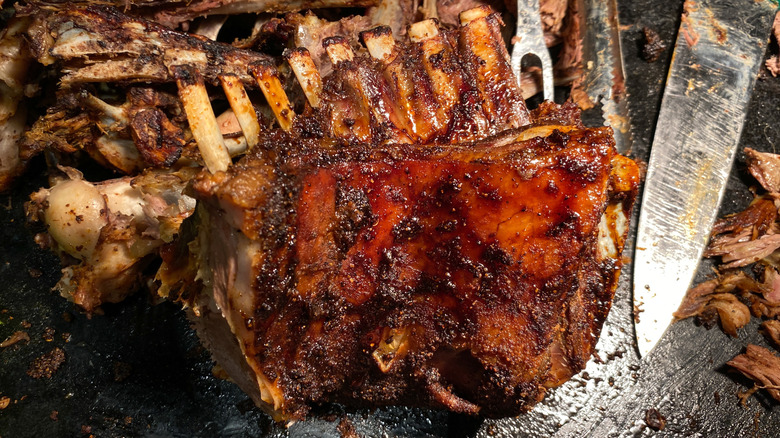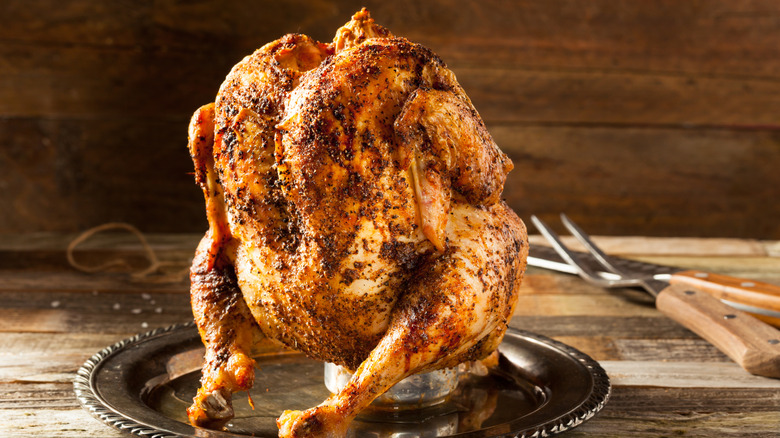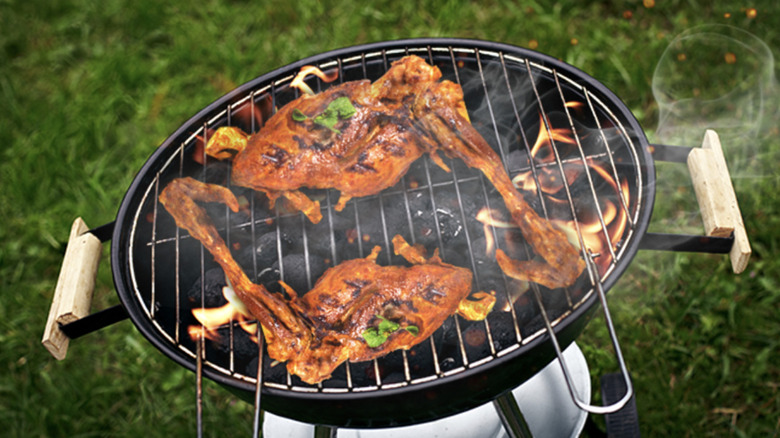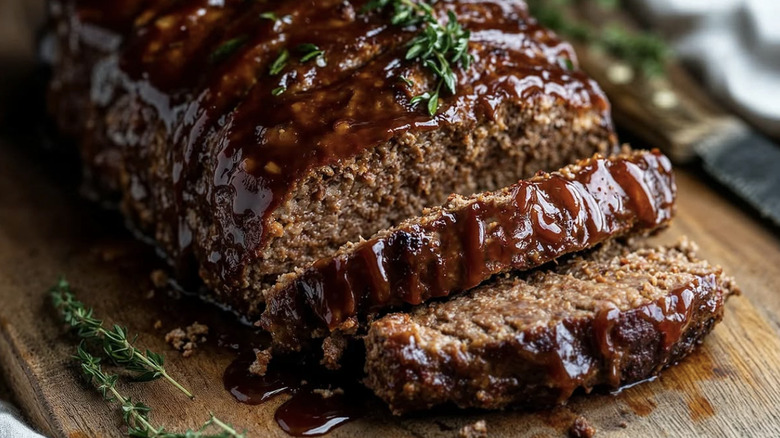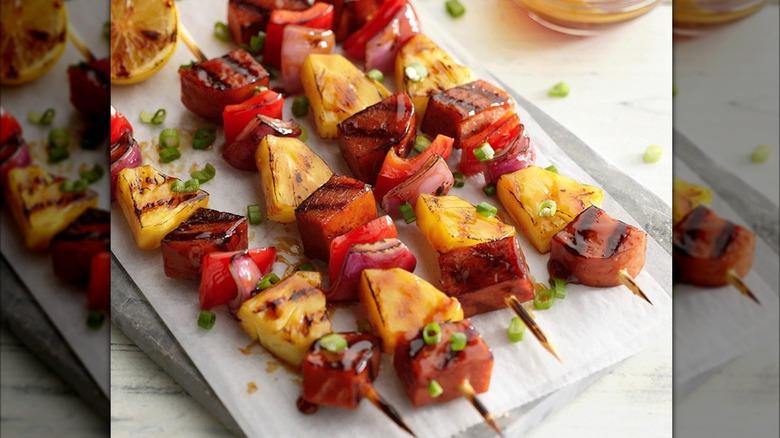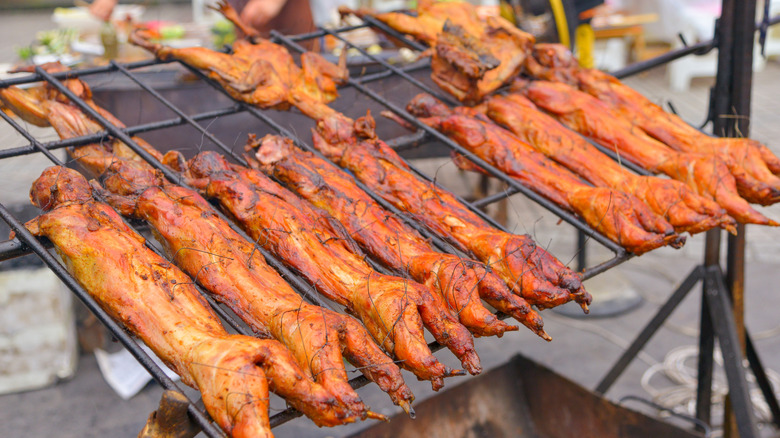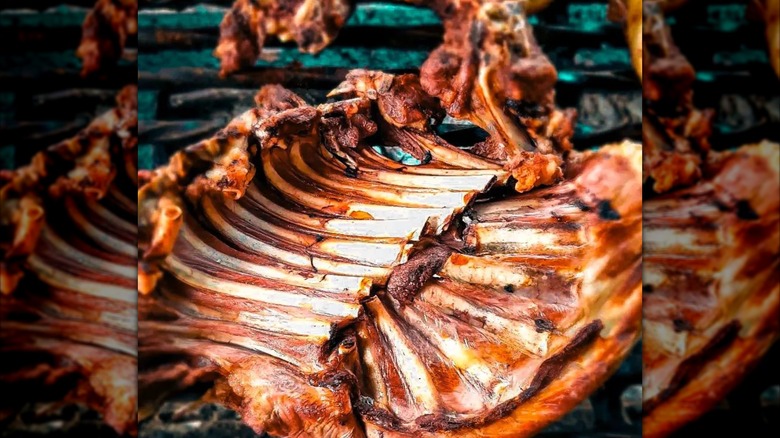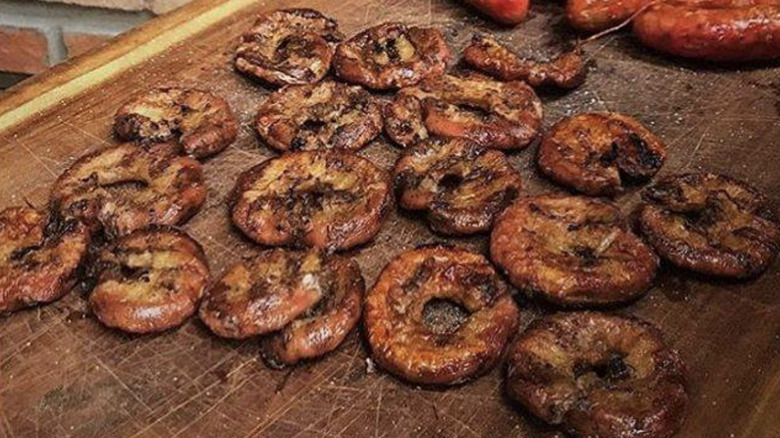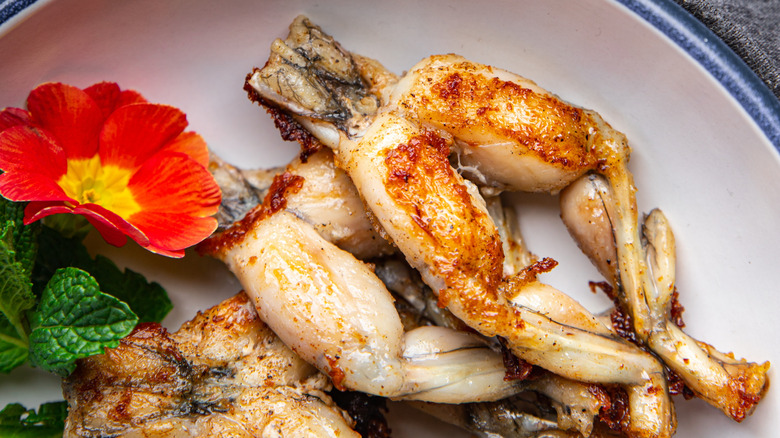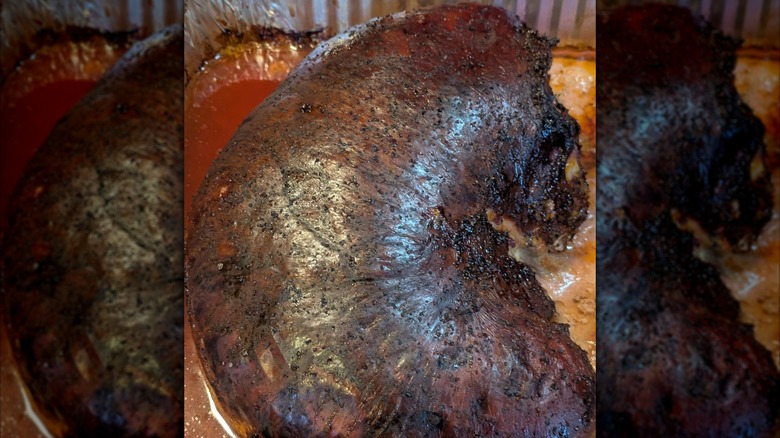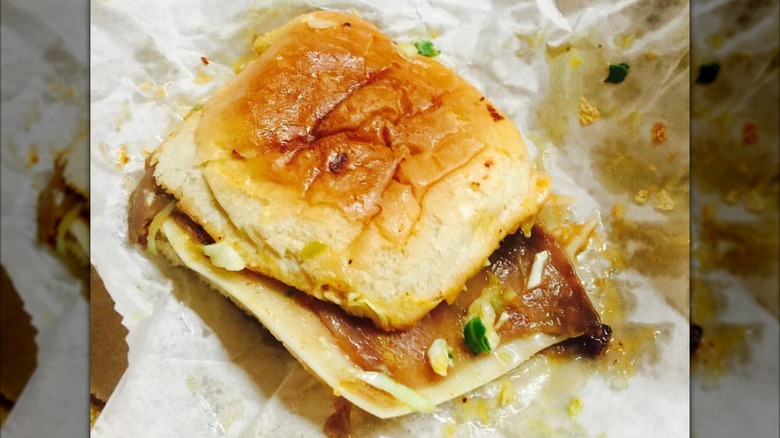Vintage BBQ Dishes That Vanished
We may receive a commission on purchases made from links.
Backyard barbecues are a beloved American tradition that brings together delicious food and social connection. More than mere outdoor grilling sessions, cookouts are about creating lasting memories bound to bring smiles for years to come. As such, it's not surprising that many of us have our barbecue favorites, from juicy cuts of steak and sausages to barbecued cauliflower and roasted veggies.
From the smell of sizzling meat to the smoky flavors of the finished feast, there is little doubt that cookouts are a real feast for the senses. However, few grilling enthusiasts realize just how much barbecues have changed over the years, and not just in terms of the equipment we use to prepare our food. There is a whole range of vintage barbecue recipes that have faded from the spotlight, many born out of regional traditions and sheer necessity.
Ready to find out what our grandparents used to barbecue back in the day? Take a look at our roundup of the most iconic old-school dishes that are no longer in vogue!
Beer can chicken
Out of the box and visually striking, beer can chicken is one of those recipes that never should have gone out of style — even if only for the visuals. What makes beer can chicken so special is the precarious positioning of the bird on the barbecue. Cooked vertically, rather than horizontally, beer can chicken is literally impaled on a — well — beer can. The brew is said to flavor the chicken as it gradually evaporates during the cooking process, although the science behind this claim is at best dubious. Considering that the safe temperature for poultry is 165 degrees Fahrenheit and the steaming temperature is 212 degrees Fahrenheit, the beer never really gets the chance to evaporate.
So where did beer can chicken find its culinary fame? While the mastermind behind the beer can cooking technique is a mystery, the recipe started making an appearance at college cookouts in the 1970s and '80s. It then gained traction through barbecue competitions, where it no doubt impressed spectators with its optics and sparked conversation among pit masters. While the recipe is no longer popular, those curious about the dish can invest in a stainless steel beer can chicken holder to recreate the spectacle in their own backyard.
Barbecued mutton
Barbecued mutton was once all the rage, especially in Daviess County, Kentucky, which had a huge wool industry in the 19th century. This meant that farmers found themselves with older — and somewhat chewier — sheep meat, or mutton, which was ideal for slow-cooking on the barbecue. For those unfamiliar with the difference between mutton and lamb, lamb comes from sheep under a year old, while mutton is sourced from older sheep, which are two years or more.
Once a dinner table staple, mutton has largely dropped off the culinary radar in the U.S. after World War II. This is mainly due to its stronger, gamey flavor and chewier texture than lamb, pork, or beef. In the age of instant gratification, many home chefs just don't have the patience for the longer cooking times required to tenderize mutton. This is a shame because when properly barbecued with spices, mutton can bring a unique and rich taste to the table. Today, barbecued mutton usually consists of the shoulder — rather than the whole sheep — which is basted in sauces made with a medley of bold ingredients like Worcestershire, garlic, lemon, vinegar, and hot peppers.
Barbecued meatloaf
A classic comfort food, meatloaf is typically made with ground meat mixed with a binder made from ingredients, such as breadcrumbs, eggs, and seasonings. The mass is then shaped into a loaf and baked in the oven. Barbecued meatloaf features a slightly different recipe, often incorporating barbecue sauce both in the meat mixture and as a glaze on top, giving the dish a smokier quality. It goes without saying that rather than being baked in the oven, barbecued meatloaf is prepared on the grill. While it may not be trendy today, meatloaf was once a popular breakfast staple, valued for its affordability and heartiness.
The humble meatloaf has a long history, dating back to Ancient Rome, when minced meat was mixed with wine‑soaked bread, spices, and pine nuts. In the U.S., a version of meatloaf was popularized by Dutch immigrants in Pennsylvania in the 18th century. The dish, which was called "scrapple," consisted of pork trimmings and cornmeal. Meatloaf gained popularity after the invention of the meat grinder in the 19th century — just imagine, before then, the meat scraps had to be minced by hand. Meatloaf's popularity continued into the Great Depression, slowly declining as the dish was replaced by processed foods and lighter meat alternatives.
Barbecued Spam kebabs
There was a time in the mid-20th century when Spam was the go-to pantry staple in the U.S. Made from a blend of pork, ham, potato starch, flavoring, and preservatives, the processed meat was convenient, shelf-stable, and affordable for those on a budget. Spam gained a widespread following during World War II, when more than 133 million cans were shipped abroad to troops and civilians from 1940 to 1945. While Spam has been embraced in some parts of the world where American soldiers had been stationed during the war, like the Philippines and Hawaii, its popularity has largely declined in the continental U.S. as fresh meat became more accessible.
In Spam's heyday, one of the most popular barbecued dishes that incorporated the canned meat was Spam kebabs. And it's not surprising — Spam does very well on the grill. The ready-to-eat meat doesn't require a lot of seasoning, handles high heat well, and tastes great when charred. If you are feeling nostalgic or simply feel like bringing to life a retro dish, barbecued Spam kebabs are also very easy to prepare. Simply chop the meat into cubes and skewer them alongside some of your favorite fruit and vegetables, such as pineapple, red onions, and bell peppers. Once ready, place the skewers on a barbecue grill, letting them sizzle until golden.
Hoecakes
According to some, hoecakes got their name because, back in the day, they were cooked on the flat side of a hoe over an open fire. Whether that's true or not is up for debate. What's certain, however, is that the flatbread has faded from the limelight. Those wishing to recreate the pancakes in the comfort of their own kitchen — or backyard — can easily do so with a few basic ingredients like cornmeal, flour, baking powder, buttermilk, and eggs.
The history of hoecakes is rooted in Southern, and more specifically Indigenous peoples' and African American, culinary traditions. A version of the dish was first prepared by Native Americans, who had already domesticated corn when European settlers arrived on the shores. The simple recipe for hoe cakes — which then likely consisted of cornmeal, water, salt, and a little grease like bacon fat — was later embraced by enslaved Americans. In fact, they are said to have prepared the flatbread on hoes during their midday breaks. Notably, the first U.S. President, George Washington, is said to have favored the humble cornmeal cakes drizzled with a little honey for breakfast.
Corn pudding
Rich, creamy, and slightly sweet and featuring a soft texture, corn pudding used to make frequent appearances as a side dish at barbecues. Unfortunately, the dish hasn't kept up with more modern — and lighter — barbecue accompaniments like coleslaws, salads, and grilled vegetables. While recipes for corn pudding vary, the classic Southern version of the hearty side is made with corn kernels, eggs, light cream or half-and-half, nutmeg, and black pepper. Once all the ingredients are combined, the casserole is baked until set, creating a custard-like dish that's speckled with corn kernels.
More modern takes on corn pudding vary, with some embracing the sweetness of the corn and others leaning toward a more savory flavor profile. Perhaps one Redditor sums this up best, saying, "You'll find flavors carry along family lines, until some rebel springs forth and disrupts tradition. People don't speak for a while afterword. After six decades, I've had enough of the sweet stuff (authentic) and I'm more interested in flavors toward savory, or even the forbidden spicy varieties. Having said that, unless it's lock-jaw sweet, I'll always put it on my plate."
Barbecued rabbit
While rabbit still plays a part in the culinary traditions of some countries like Italy and France, the meat is no longer popular in the U.S. In fact, it's hard to imagine that rabbit meat was ever popular here. Nevertheless, the reality is that just like in many other countries around the globe, Native Americans hunted wild rabbits since time immemorial. Later, European settlers introduced domesticated rabbit breeds to the country, raising them as a source of both meat and fur. Rabbits were commonly eaten during World War II as a cheap source of protein when other meat became scarce. However, as beef, pork, and chicken became more affordable and accessible after the war, rabbit meat fell out of favor with consumers.
During its golden age, rabbit meat was a common sight at cookouts. Low in fat and cholesterol and high in protein, it was valued for its mildly sweet flavor and versatility. One of the most common ways to barbecue rabbit was whole or split, skewered on sturdy sticks or rods. The meat would then be roasted over an open fire, a cooking technique that gave it a smoky, rustic flavor profile.
Barbecued goat ribs
Most of us are familiar with goat cheese, but few have ever considered eating goat meat. The reality is that goat meat has never been as popular in the U.S. as beef, lamb, or chicken. Nevertheless, it has been enjoyed by certain regional or immigrant communities. One example of this is cabrito al pastor, a dish of spit-roasted kid goat seasoned with spices. Still sometimes prepared in South Texas, cabrito reflects the culinary traditions of Mexico that have influenced America's food culture.
While barbecuing an entire goat is no small feat — imagine the continuous basting over three and a half to four hours — preparing goat ribs isn't as labor-intensive. Since goat meat is tougher than beef, it's important to barbecue the ribs low and slow to ensure optimal tenderness. Sourced from the upper central region of the animal, goat ribs have a subtle, gamey flavor that tastes a little like beef. In addition, goat meat is high in potassium, iron, and vitamin B12, and low in cholesterol.
Chitlins
A textbook example of an organ meat dish, chitlins are made from the small intestines of a pig. Also sometimes called chitterlings, the dish is typically boiled or fried, but can also be slow-cooked on a barbecue. Known for their chewy texture and strong smell during cooking, chitlins can be off-putting to modern palates. They are also rather labor-intensive to prepare due to the involved cleaning process. If not cleaned properly, chitlins can lead to yersiniosis, a bacterial infection with symptoms such as diarrhea, fever, and abdominal pain. Considering all this, it's easy to see why today's diners may not appreciate this savory dish.
While it may not be popular today, chitlins have strong ties to the Southern culinary tradition and more specifically African American gastronomy. Enslaved people, who were often left with the less desirable animal parts, including intestines, had to get creative to transform them into nutritious — and tasty — meals. Without access to the so-called prime cuts, which were eaten by the plantation owners, enslaved people came up with dishes such as pickled pig's trotters, hog's head cheese, and chitlins.
Barbecued frog legs
Frog legs are associated with French cuisine, where they are typically fried or sautéed in a little butter, parsley, and garlic. In fact, the French are said to consume approximately 4,000 tons of frog legs each year. This number is much smaller in the U.S., where frog legs are more commonly associated with novelty food and haute dining than with a protein staple. After all, it's difficult to imagine your average American family standing around a barbecue packed with sizzling frog legs.
While frog legs never reached the popularity of some other meats in the U.S., they were fairly common in the 18th and 19th centuries, especially in areas with French influence like St. Louis and Detroit. A case in point is early 20th‑century Detroit where the amphibians were served in restaurants, roadhouses, and hotels. In 1905, Samuel Blythe waxed lyrical about the dish in the New York World: "Frog's legs — the American Brand — were invented and patented in Detroit. All others are imitations and infringements. None is genuine without the Detroit taste. [...] If you have never eaten frog legs in Detroit, you have something to live for, something for which to strive," (via Hour Detroit).
Hog maw
Most of us realize that sausages are often encased in the small intestines of a pig. However, not a lot of people have heard of hog maw, which is a dish that uses the stomach lining of a pig as a pouch for a mixture of potatoes, sausage, onion, celery, and spices. While today hog maw may seem somewhat unappetizing, this wasn't always the case — after all, a pig only has one stomach, which in the past could make it hard to procure.
A case in point is Nancy Roan's guide to handling a pig stomach in 1978 "Boyertown Area Cookery," as highlighted by one Facebook user. "Should you become the 'proud' owner of an uncleaned pig stomach, this is the way to tackle the cleaning job. Empty the original contents by cutting a slit at one of the natural openings and turning it inside out. Rinse thoroughly, and then while still inside out carefully remove, by pulling, the coating or lining of the stomach. [...] Then rinse again and put to soak in salt water for several hours."
Hog maw used to be particularly popular in the Pennsylvania Dutch region and the American South, where it was introduced by German settlers. More specifically, the hearty dish shares its roots with saumagen, a Southwestern Germany dish made from pig's stomach and fillings. Adopted by African Americans, hog maw became a part of the region's soul food, until changing tastes and increased access to meat led to its decline in popularity.
Pig ear sandwich
Given that many of us associate pig ears with dog treats, it's hard to imagine that they were once a common part of working-class lunches. Whether barbecued or fried, pig ears were once a key ingredient in pig ear sandwiches. Sliced and served between white bread or a bun, pig ears were once a beloved Southern staple. Cook Lavette Mack explained the appeal of the handheld in a 2020 interview with BBC, saying, "The ears give you lots of juiciness and tasty pork flavours all at the same time. [...] Add a little crunch with some slaw, give it a kick with some homemade hot sauce, put it all together in a bun and you've got yourself something really special."
So why did pig ear sandwiches fall out of favor with modern-day diners? One of the main reasons could be their challenging and unfamiliar texture. To cut a long story short, the chewy cartilage combined with a gelatinous exterior didn't suit the evolving preferences of consumers. In addition, as time went by, more tender meat options became easier to access, leaving diners with more culinary options.
Despite its fall from grace, the humble pig ear sandwich was once the darling of Southern food culture. Even the late culinary guru, Anthony Bourdain, once described it as "hard to beat" in an episode of "Parts Unknown." The reality television show saw Bourdain devour the culinary marvel at the historic Big Apple Inn in Jackson, Mississippi, where the pig ear slider remains on the menu.
